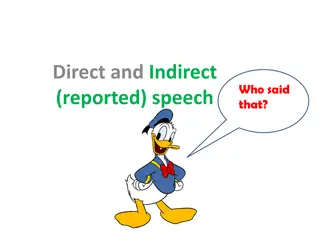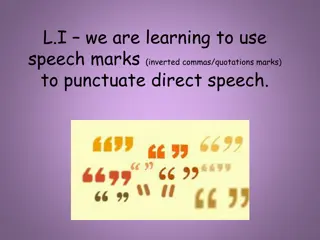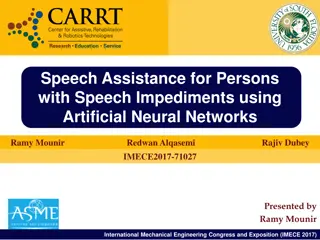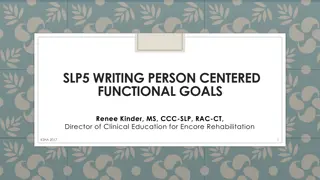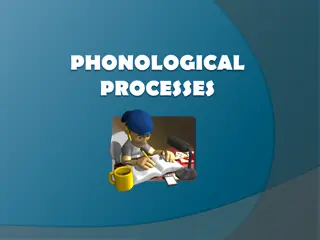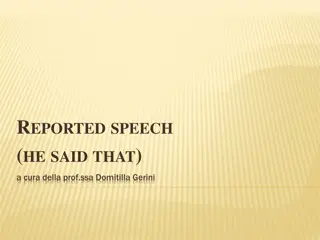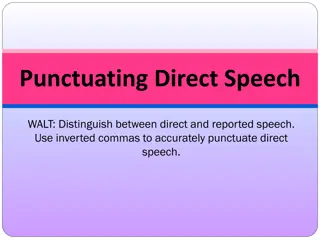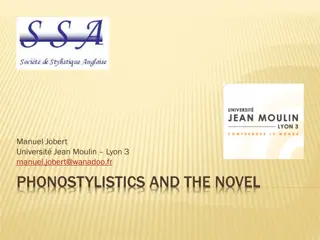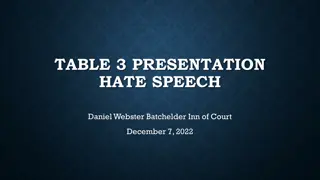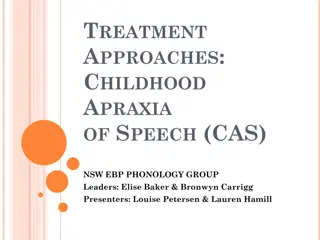English Connected Speech Processes
Explore the concepts of strong and weak forms in English pronunciation, including assimilation, elision, and coalescence. Learn about how certain words undergo changes in pronunciation in connected speech contexts. Practice transcribing examples of elision in words like "Worcester library's opening on Wednesdays in February."
Download Presentation

Please find below an Image/Link to download the presentation.
The content on the website is provided AS IS for your information and personal use only. It may not be sold, licensed, or shared on other websites without obtaining consent from the author.If you encounter any issues during the download, it is possible that the publisher has removed the file from their server.
You are allowed to download the files provided on this website for personal or commercial use, subject to the condition that they are used lawfully. All files are the property of their respective owners.
The content on the website is provided AS IS for your information and personal use only. It may not be sold, licensed, or shared on other websites without obtaining consent from the author.
E N D
Presentation Transcript
Phonetics & Phonology John Corbett: USP-CAPES International Fellow Session 4: Sounds in context: elision, assimilation, etc
This session: Strong and weak forms Connected speech processes: Assimilation Elision Coalescence Linking and intrusive /r/ Changing the shape of a word
A set of words in English have strong forms stressed weak forms - unstressed Strong and weak forms
Example Strong and weak forms I washere strong /w z/ /w z/ /w z/ /w z/ etc I was here weak
60+ such words in English of cup of tea them tell them about it / m/ him I said to him that all that he said will I ll go would I d go and fish and chips strong weak / v/ / v/, / v/ etc / m/, / m/ /h m/ / m/ Strong and weak forms / at/ / t/ etc /w l/ /l/ /wud/ /d/ /and/ /n/
Identify the weak forms
When one segment becomes more similar to a neighbouring sound, because of the influence of that sound Connected speech processes: Assimilation /n/ /m/ before /p/ /n/ / / before /k/ /s/ / / before / / in Paisley in Carluke this shop (cf. fish shop)
Loss of segment(s) or syllable(s) brand new elision of /d/ Connected speech processes: Elision last night elision of /t/ class tests [t s ] elision of second /t/ policemen s vests [plismnz v s ] elision of / /, /t/ Worcester library s opening on Wednesdays in February
Transcribe this!! Worcester library s opening on Wednesdays in February! Connected speech processes: Elision
Transcribe this!! Worcester library s opening on Wednesdays in February! Connected speech processes: Elision /wu:st la briz pn n w nzde z n f br /
Connected speech processes: Elision + Assimilation can apply in sequence second hand policemen s vests /hand p / /han p / elision /ham p / + assimilation
Connected speech processes: Elision + Assimilation can apply in sequence second hand policemen s vest shop /v st / /v s / elision /v / + assimilation
When two phonemes merge to produce a third, different phoneme /d j/ / / e.g. would you Coalescence /wud ju/ /wu u/
The pronunciation of /r/ at the ends of words in accents that dont normally have /r/ in this position (a.k.a. non-rhoticaccents) beer beer and wine far far away /bir/ (ScE) /b r n wa n/ (RP) /far/ (ScE) /f r we / (RP) /b / (RP) Linking /r/ /f / (RP)
Like linking /r/, but in words where there is no <r> in the spelling. Intrusive /r/ idea the idea of it law law and order /a d / (RP) /a d r v t/ (RP) /l / (RP) /l r n d / (RP)
Q. Why do connected speech processes happen? A. Because the vocal organs aren t like the keys of a typewriter. They don t move discretely (i.e. in jumps), but continuously Skilled movements are smooth and efficient We prepare in advance for upcoming articulations We leave out non-essential parts
There are some problems affectingsome Portuguese speakers of Englishwhenthey pronouncesoundsin sequence, e.g. The insertionof intrusiveorextra ( epenthetic vowels) between, before or afterconsonants. Try sayingthe followingwords: /kl z/ /sti:m/ /p :k/ /ge t/ /k b/ clothes steam park gate cab Transferissues Howwouldyouteachlearnerstocorrect the first ofthese words? Tohear theseintrusivesounds listentotheBrazilianpuma saying space in the followingclip: http://www.youtube.com/watch?v=xe8_aka_qlw
Sometimes, however, some Portuguesespeakers of English dropfinal unstressed vowels, orunstressed vowels towards the end ofwords. Try pronouncingthe following words: city /s te/ coffee/k fe/ office / f s/ More transfer issues Watchthe Brazilianpuma clip again. Canyouhearanyexamples ofdropped unstressed vowels? Are there anyother transferissues withthe puma spronunciation?
Connected speech processes - They can change the shape of a word: BUT they don t necessarily make words more difficult to understand for L1 speakers They may offer a challenge to L2 learners listening. Since the phonological systems of Brazilian Portuguese and English are different, there might be negative transfer of Brazilian Portuguese phonological processes to English speech. Summary


![Prevention and Combating of Hate Crimes and Hate Speech Bill [B.9B.2018]](/thumb/60513/prevention-and-combating-of-hate-crimes-and-hate-speech-bill-b-9b-2018.jpg)


